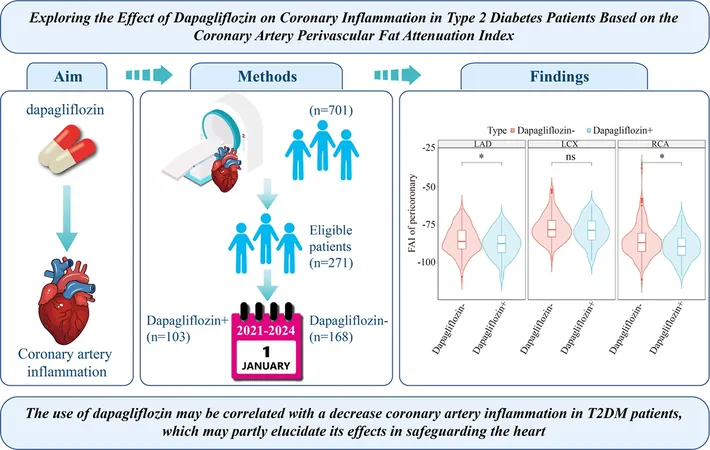
Revolutionizing Heart Health: The Impact of Dapagliflozin on Coronary Inflammation in Type 2 Diabetes
2025-04-18
Author: Siti
Unraveling the Mystery of Heart Disease in Diabetes Patients
A staggering 536.6 million adults worldwide were living with diabetes as of 2021, a number that could rise to 783.2 million by 2045. At the forefront of this epidemic is Type 2 Diabetes Mellitus (T2DM), which accounts for 90-95% of diabetes cases and poses significant cardiovascular risks. Patients with T2DM face an alarming 32.2% prevalence of atherosclerotic cardiovascular disease (ASCVD), making it a leading cause of mortality.
Dapagliflozin: A Game-Changer for Cardiac Health
Among the emerging treatments for T2DM, dapagliflozin stands out not just for managing blood sugar levels but for its potential cardioprotective and renoprotective effects. By inhibiting sodium-glucose cotransporter 2 (SGLT2), dapagliflozin lowers blood glucose and promotes weight loss. Recent studies indicate it may also lower the risk of cardiovascular events—a pressing concern for T2DM patients.
The Role of Pericoronary Fat Attenuation Index (FAI)
The Pericoronary Fat Attenuation Index (FAI) is emerging as a critical biomarker that reflects coronary artery inflammation. More than just a number, FAI provides insights into the local inflammatory processes affecting coronary health. By measuring the density of adipose tissue surrounding the coronary arteries, it serves as a vital tool for identifying vulnerable arterial plaques and, consequently, predicting cardiovascular risk.
Study Overview: Dapagliflozin's Efficacy on FAI
In a groundbreaking study at Hebei Provincial People’s Hospital, researchers examined 271 T2DM patients. They compared those receiving dapagliflozin (103 patients) against those who were not (168 patients). The study analyzed various metrics, including baseline clinical data and coronary imaging, to unpack the relationship between dapagliflozin and coronary inflammation as indicated by FAI.
Key Findings: A Clear Connection between Dapagliflozin and Reduced Inflammation
The results were striking: Patients on dapagliflozin exhibited lower FAI values in the left anterior descending artery (LAD) and right coronary artery (RCA) compared to non-users. Specifically, lower values correlated with decreased coronary inflammation, indicating this treatment may play a crucial role in mitigating cardiovascular risk among T2DM patients. Adjustments for variables like age and duration of diabetes affirm that this link is substantial and significant.
Who Benefits Most? Insights from Patient Subgroups
Notably, younger patients (under 70) and those diagnosed for less than 10 years responded more positively to dapagliflozin, demonstrating decreased coronary inflammation. Interestingly, men benefitted more substantially from the treatment compared to women, further highlighting the importance of personalized medicine in diabetes care.
Why This Matters: The Future of Diabetes Treatment
With the alarming rise of diabetes-related cardiovascular complications, understanding the mechanisms through which dapagliflozin improves coronary health is essential. This research not only questions traditional biomarkers but also suggests that effective monitoring of pericoronary FAI could revolutionize risk assessment and stratification for high-risk patients.
Conclusion: A Heartfelt Innovation Against Diabetes Complications
Dapagliflozin has emerged as a beacon of hope for T2DM patients by significantly lowering coronary artery inflammation. This could pave the way for new treatment protocols aimed at improving overall cardiovascular outcomes. Future studies should continue to explore the nuanced interplay between dapagliflozin and coronary health, potentially redefining strategies in diabetes management and prevention of heart disease.



 Brasil (PT)
Brasil (PT)
 Canada (EN)
Canada (EN)
 Chile (ES)
Chile (ES)
 Česko (CS)
Česko (CS)
 대한민국 (KO)
대한민국 (KO)
 España (ES)
España (ES)
 France (FR)
France (FR)
 Hong Kong (EN)
Hong Kong (EN)
 Italia (IT)
Italia (IT)
 日本 (JA)
日本 (JA)
 Magyarország (HU)
Magyarország (HU)
 Norge (NO)
Norge (NO)
 Polska (PL)
Polska (PL)
 Schweiz (DE)
Schweiz (DE)
 Singapore (EN)
Singapore (EN)
 Sverige (SV)
Sverige (SV)
 Suomi (FI)
Suomi (FI)
 Türkiye (TR)
Türkiye (TR)
 الإمارات العربية المتحدة (AR)
الإمارات العربية المتحدة (AR)